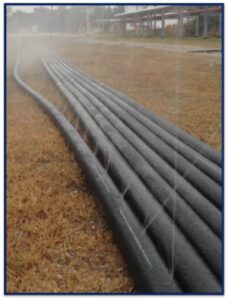How Does Soil Vapor Extraction Remediate Contaminated Soil and Groundwater?
Soil Vapor Extraction (SVE) involves the removal of vapor-phase contaminants from the vadose zone of the subsurface. The vapors are created when chemical compounds found in the subsurface volatilize. During soil vapor extraction, a vacuum is applied to a soil vapor extraction well which pulls the vapors out of the subsurface so that they can be treated at the surface. Soil vapor extraction reduces concentrations of hazardous vapors present in the soil. Vapors are extracted through the horizontal SVE well through the use of blowers and similar equipment. The extracted vapors are often treated with the use of filter materials such as activated carbon or can simply be vented away from interior spaces to prevent soil vapor intrusion and preserve indoor air quality. Through the processes of soil vapor extraction, contaminant concentrations can be reduced and harmful chemical vapors can be prevented from affecting air quality at the surface. Soil vapor extraction systems are often paired with air sparging techniques to enhance remediation. Air sparging wells can convert volatile and semivolatile chemical compounds to vapors to remove contaminant mass from the subsurface and soil vapor extraction can be used to capture the off-gasses produced by the air sparging. Soil vapor extraction is an effective treatment for various common types of contamination associated with petroleum and chlorinated solvents.
 What Are the Advantages of Using Horizontal Wells for Air Sparging?
What Are the Advantages of Using Horizontal Wells for Air Sparging?
Vertical wells are the most common method to install a soil vapor extraction system. However, various site limitations can make vertical wells challenging to implement effectively. Common site conditions which limit the efficacy of vertical wells include lack of access to the area above the plume due to infrastructure or sensitive areas, industrial/commercial/residential uses of the property which cannot easily tolerate interruptions during remedial construction, and O&M, challenging geology, and future site redevelopment. Horizontal remediation wells are frequently utilized to overcome these site conditions and install air sparge systems. Unlike conventional vertical remediation wells, horizontal remediation wells can access the contaminant plume from almost anywhere through the use of directional drilling techniques. Not only do horizontal remediation wells allow you to access the plume, they are also far more effective at cleaning up contamination. A horizontal SVE well screen allows significantly more contact with the contaminant plume, allowing for more efficient treatment of wider areas of the subsurface. They can also be precisely targeted to focus on problematic hot spots. The resulting radius of influence that can be achieved by horizontal remediation wells allows for enhanced remediation performance and less time to meet cleanup goals.
Soil vapor extraction is an effective way to reduce various common types of contamination. Horizontal soil vapor extraction techniques are proven to provide the most effective implementation of soil vapor extraction remediation by providing unparalleled access to the contaminant plume and enhanced treatment of soil vapor. If you have a contaminated site that could benefit from horizontal soil vapor extraction, please click HERE to tell us about your project so that we can help you determine whether horizontal air sparge may be an effective solution.